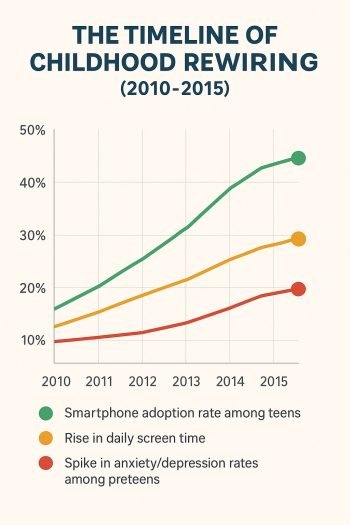The Digital Dilemma: How Smartphones are Rewiring Childhood and Fueling a Mental Crisis
The Child Mind Institute Podcast with Jonathan Haidt and Dr. Dave Anderson |
October 30, 2025
In the early 2010s, something shifted—quietly, rapidly, and with massive consequences. Within just five years, childhood itself was rewired. Playgrounds emptied, bedrooms glowed blue with screens, and anxiety and depression among kids and teens skyrocketed.
According to social psychologist Jonathan Haidt, author of The Anxious Generation, and Dr. Dave Anderson of the Child Mind Institute, we are now raising the first “post-play generation.” Kids have traded outdoor adventures for algorithm-driven feeds, and the effects on their mental health are impossible to ignore.
This post unpacks their powerful conversation about technology, childhood, and mental health, and offers practical solutions for parents, schools, and policymakers to help kids thrive in a digital age.

The End of Play: How Childhood Got Rewired
Until the late 1990s, most children spent afternoons riding bikes, building forts, or exploring their neighborhoods. They learned independence and resilience through free play—those unsupervised hours that shaped emotional growth.
Then came overprotection and overscheduling, fueled by fears of danger and the rise of screen-based entertainment. By the 2010s, free play had nearly disappeared. Haidt calls this new era “a post-play childhood”—a time when screens replaced exploration, and childhood became less about doing and more about scrolling.
“If mammals need play to wire their brains,” Haidt warns, “then a generation deprived of play is like plants denied water.”
The 2010–2015 Great Rewiring
Between 2010 and 2015, smartphones, social media, and front-facing cameras fundamentally changed childhood. Kids born after 2000—Gen Z—hit puberty with Instagram and Snapchat in hand, not flip phones. The constant stream of likes, filters, and feedback rewired the way they saw themselves and others.
For preteen girls, the impact was devastating: skyrocketing rates of anxiety, depression, and self-harm. For boys, the damage appeared differently—addiction, distraction, and loss of motivation.
Key takeaway: The shift from “play-based” to “screen-based” childhood is the most rapid lifestyle change in human history—and it’s reshaping kids’ brains and emotions in unprecedented ways.
Social Media’s Business Model: Addiction by Design
The problem isn’t just the internet—it’s social media’s engagement-driven business model.
Platforms like Facebook, Instagram, and TikTok weren’t designed for communication or creativity; they were designed to maximize time on app. Engineers were rewarded for increasing user engagement “by any means necessary.”
That meant endless notifications, infinite scrolls, and algorithms tuned for dopamine hits—the same “variable ratio reward” schedule used in slot machines. As Haidt explains, “If gambling is an addiction, this is too.”
The Algorithm Trap
- Early Facebook (pre-2010): static pages, minimal toxicity.
- Post-2012 Instagram: filters, likes, and endless comparison loops.
- Snapchat: disappearing messages and anonymity—perfect for predators and drug dealers.
These design choices have real-world consequences. Studies and lawsuits reveal that predators, cyberbullies, and exploiters thrive in unregulated, anonymous chat features. Platforms profit from engagement—even if that engagement destroys lives.
Practical Tip: Parents should treat engagement-based apps (TikTok, Snap, Instagram) like addictive products, not harmless tools. If your child must use them, limit time and control contacts—for example, “10 minutes a day and no more than 50 friends.

The Mental Health Fallout: Anxiety, Addiction, and Disconnection
At the Child Mind Institute, Dr. Dave Anderson sees the crisis firsthand. He describes a generation struggling to balance digital life with real life.
“We’re not taking the genie out of the bottle,” Anderson says. “Our job is to help kids integrate technology in ways that protect their well-being.”
Girls: The Anxious Generation
For girls, the dangers center on social comparison and validation loops. The more they scroll, the worse they feel. The curated highlight reels of peers distort reality, feed body-image issues, and erode confidence.
Data shows: Heavy social media users among girls are 2–3 times more likely to suffer from anxiety or depression.
Boys: The Distracted Generation
Boys, meanwhile, are drowning in dopamine-driven distractions. Video games, porn, and online gambling hijack focus and reward circuits, leaving many unmotivated and disconnected from real-world goals.
While boys may seem “fine” at 14, the fallout hits later: lower graduation rates, fewer relationships, and declining job prospects.
Key takeaway: Girls are growing anxious and self-critical; boys are losing focus and drive. Both are casualties of a digital ecosystem optimized for addiction.
Parents on the Front Lines
Tech companies argue that regulating kids’ screen time is a parental responsibility. But as Anderson points out, that’s an impossible ask.
Parents today face an asymmetrical battle: kids with instant access to apps designed to bypass self-control. Even tech executives send their own children to device-free Waldorf schools—while selling the rest of us “connected learning.”
Real-Life Example: A mother of a 9-year-old told Dr. Anderson she felt powerless when her child’s school sent home a laptop daily. Within weeks, screen rules at home were out the window. As he put it, “Parents need a map, not guilt.”
Practical Tips for Parents
- Start early with digital literacy—talk about online risks before your child goes online.
- Model healthy use—put your own phone down during meals and family time.
- Create tech-free zones—especially bedrooms and mealtimes.
- Set shared limits—coordinate with other parents so your child isn’t “the only one.”
- Have “Good Samaritan” talks—let your child know they can come to you if they’re targeted or sextorted without fear of punishment.
The Family Digital Wellness Checklist
| Wellness Factor | Why It Matters | Questions to Ask |
|---|---|---|
| Sleep | Poor sleep amplifies anxiety and irritability | Does your child use screens within an hour of bed? |
| Physical Activity | Movement resets dopamine balance | Are they active at least 60 minutes a day? |
| Real-Life Friendships | In-person bonds build resilience | Do they regularly meet friends offline? |
| Family Time | Builds security and empathy | Are there screen-free meals daily? |
| Purposeful Learning | Boosts attention and confidence | Are they engaged in extracurriculars? |
Schools at a Crossroads
Education is another front in the tech-mental health battle.
Despite promises of “digital transformation,” evidence shows devices in classrooms hurt attention, test scores, and engagement.
Jonathan Haidt’s recommendation:
- Phone-free schools. No phones in pockets, not even during breaks.
- Rollback of EdTech, especially in elementary school.
- More recess and outdoor play.
“Federal prisoners get more yard time than most kids,” Haidt notes. “That’s not normal.”
Dr. Anderson’s view adds another layer: removing phones isn’t enough. Schools also need more counselors, better prevention programs, and engaging, project-based learning to rebuild curiosity and connection.
Why Policy Still Lags Behind
Despite bipartisan concern, Congress has failed to pass even basic protections like the Kids Online Safety Act (KOSA). Haidt blames intense tech lobbying:
“Meta will spend any amount of money to block federal legislation.”
Still, progress is happening elsewhere. Australia, Brazil, and several U.S. states have raised social media age limits or banned phones in schools. Parents and state leaders—especially mothers—are driving the movement faster than Congress ever will.
Key takeaway: Change won’t come from Washington; it will come from parents, schools, and state leaders who refuse to wait.
Four Reforms for a Healthier Generation
Haidt outlines four low-cost, high-impact steps to restore a healthy childhood:
- No smartphones before high school. Give kids basic flip phones for safety and communication.
- No social media before 16. The developmental risks far outweigh the benefits.
- Phone-free schools. Reclaim classrooms for learning, not scrolling.
- More independence and free play. Let kids explore, fail, and grow without constant supervision.
“If we do these four things,” Haidt says, “it’s like giving water back to plants.”
Each of these reforms costs almost nothing—but could radically improve childhood mental health.
A Growing Concern: AI and “Companion Bots”
As artificial intelligence integrates into everything, new risks are emerging.
Dr. Anderson warns of AI “companions”—chatbots designed to simulate friendship or romance. Teens are forming emotional attachments to these bots, blurring the line between human connection and digital fantasy.
Key takeaway: AI won’t just amplify the problem—it will personalize addiction. The time to build digital resilience is now.
The Path Forward: Building Digital Resilience
There’s no going back to 1995. But there is a path forward—one grounded in balance, boundaries, and intentional design.
For Parents
- Treat screen time like nutrition: focus on quality over quantity.
- Replace restriction with redirection—sports, music, nature, creativity.
- Partner with schools to create consistent digital rules.
For Schools
- Go phone-free.
- Reintroduce daily recess and unstructured play.
- Invest in mental health staff and parent education.
For Tech Companies
- Implement “Know Your Customer” policies to prevent anonymous predator access.
- Compete on safety and transparency, not engagement metrics.
- Stop exploiting children’s attention as a revenue source.
A Hopeful Note
Every summer, parents see a glimpse of what’s possible. Kids go to device-free camps, rediscover friendships, creativity, and laughter. For a few weeks, they become themselves again.
When they come home, parents face a choice: hand the phone back—or keep the magic going.
“Summer camp is like detox for the dopamine system,” Haidt says. “Don’t undo the progress when they return.”
Conclusion: Reclaiming Childhood in a Digital World
The youth mental health crisis isn’t a mystery—it’s a mirror. We built an environment where screens replaced social life, comparison replaced connection, and dopamine replaced meaning.
But we also hold the power to reverse it.
The fix begins with four small steps: delay devices, protect play, go phone-free in schools, and rebuild real-world connection. The future of childhood—and our collective well-being—depends on it.
Download the Daily Digital Wellness Checklist
Take control of your family’s screen time and mental health with our Daily Digital Wellness Checklist — a simple, science-backed plan inspired by experts Jonathan Haidt and Dr. Dave Anderson. Use it to create balance, build healthy habits, and help kids thrive in a digital world.
Related Post



